Family : Serranidae

Text © Giuseppe Mazza

English translation by Mario Beltramini
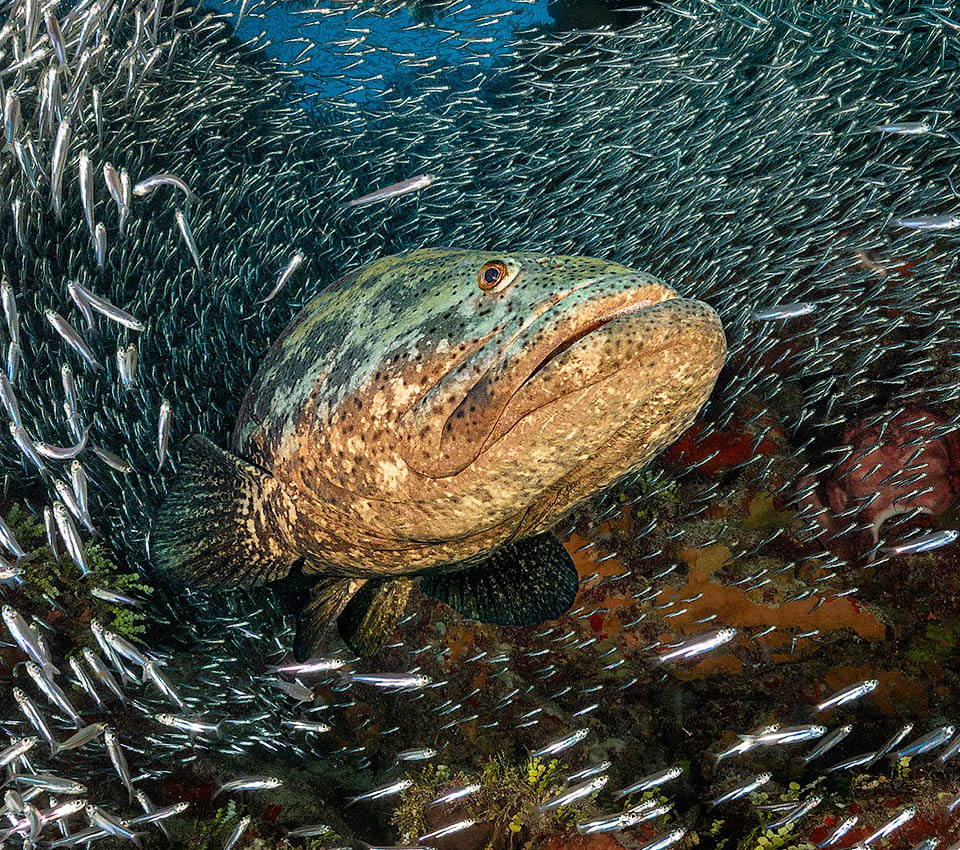
With 2,5 m of length and even 465 kg of weight, the Atlantic goliath grouper (Epinephelus itajara), stands among the biggest existing © David Keep
In addition to one of the smallest extant groupers, Cephalopholis fulva, usually 25 cm long, the Caribbean hosts also the giant Epinephelus itajara (Lichtenstein, 1822), called Atlantic goliath grouper that reaches 2,5 m of length and the unbelievable weight of 455 kg, once mistaken with Epinephelus quinquefasciatus, species of analogous size of eastern Pacific.
It belongs to the class of the Actinopterygii, the ray-finned fishes, to the order of the Perciformes and to the family of the Serranidae, subfamily Epinephelinae.
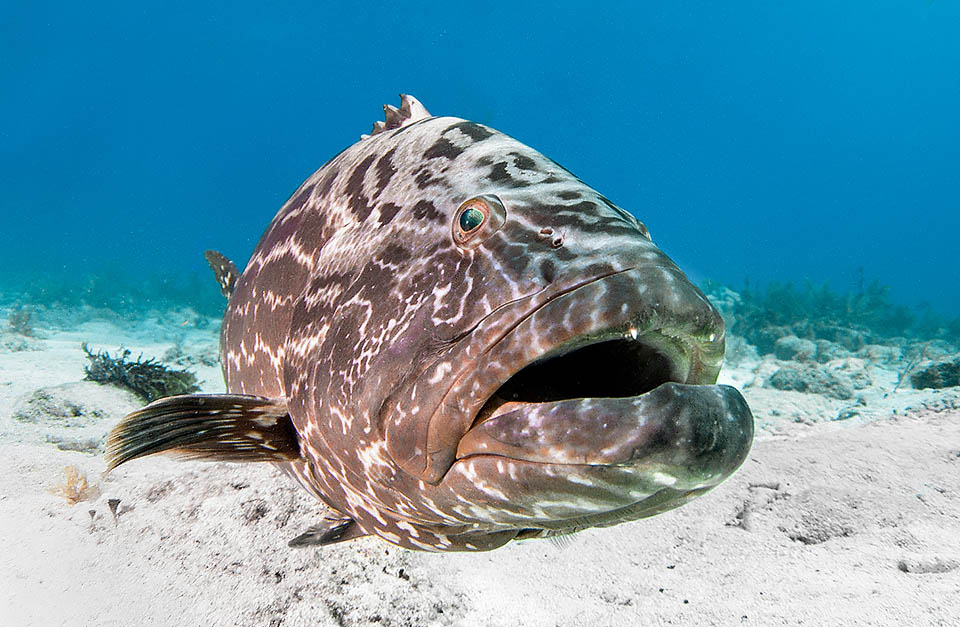
It lives in America, from Florida to the southern coasts of Brazil, and in Africa from Senegal to Congo © Karen Honeycutt
The etymology of the genus Cephalopholis comes from the Greek “epinefes”, cloudy, with reference to the nebulous mimetic drawings, whilst the specific term itajara, in Malay meaning “king” probably comes from the confusion with Epinephelus lanceolatus, a slightly bigger grouper of the Indo-Pacific.
Zoogeography
Even if, unluckily, with decreasing populations, Epinephelus itajara has a very vast range on both Atlantic shores.
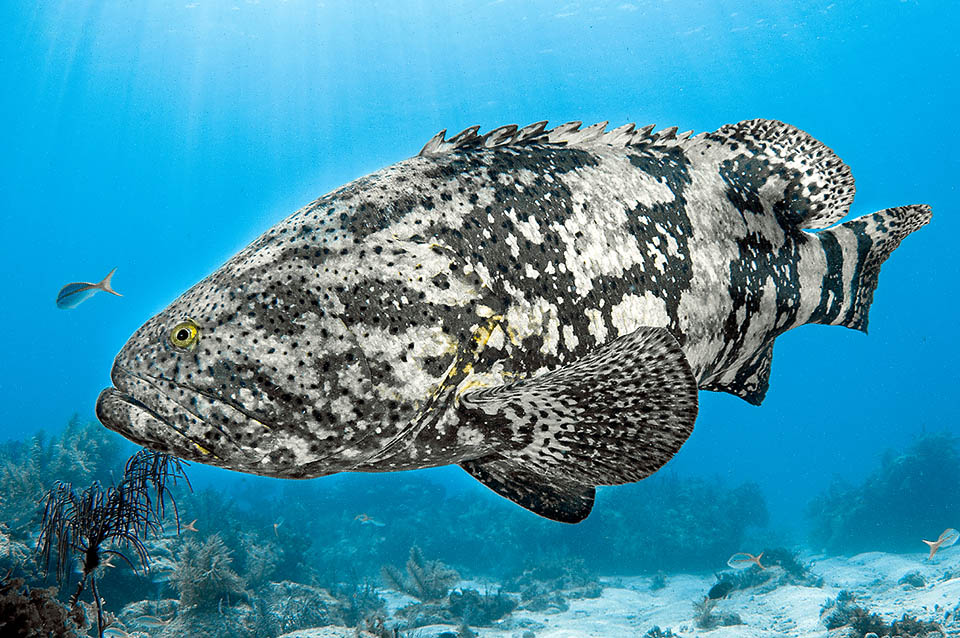
The robust and elongate body, tawny or grey, has a marbled mimetic drawing with pale spots with a black dotting more intense on the head, the back and on the fins © Karen Honeycutt
In America it is present from Florida to the southern Brazilian coasts, and in Africa from Senegal to Congo,where it is sometimes known with the synonym of Epinephelus esonue.
Ecology-Habitat
The Atlantic goliath grouper is present in various environments up to 100 m of depth: sandy bottoms and madreporic formations but mainly rocky coasts with a predilection for the wrecks of ships it uses as den, and the oil platforms.
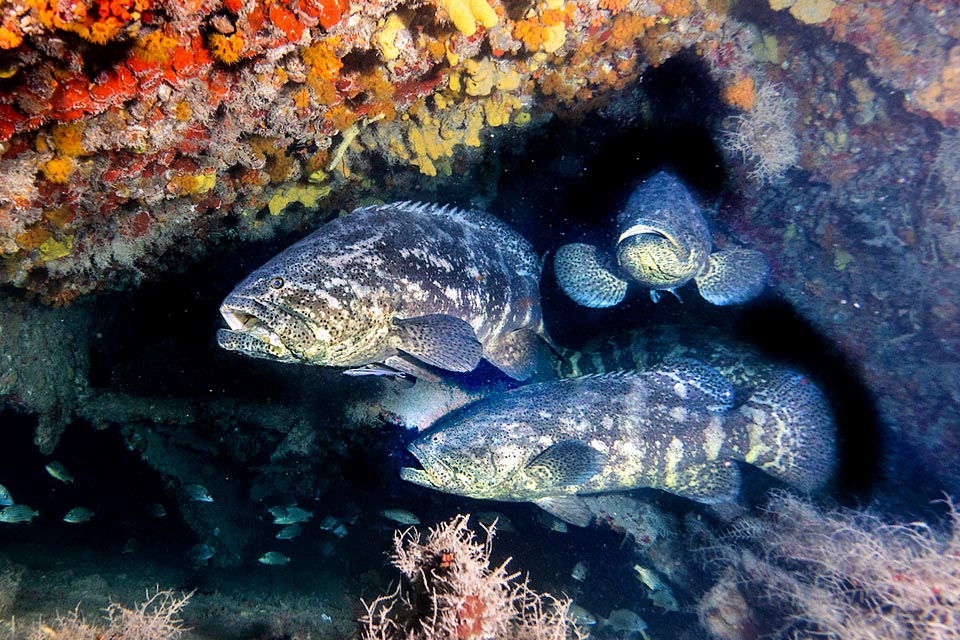
It is present in various environments up to 100 m of depth: sandy bottoms and madreporic formations, but mainly rocky coasts © Allison & Carlos Estape
It also accepts the brackish waters and goes up the river mouths. The juveniles spend almost always their first 5-6 years of their life among the mangrove formations, a very important ecosystem for the survival of the species.
Morphophysiology
Epinephelus itajara has a robust and elongated body, mostly brownish or grey, with a marbled camouflage design with clear and dark spots that in the less than one metre long individuals form 3-4 weak vertical bands on the sides.
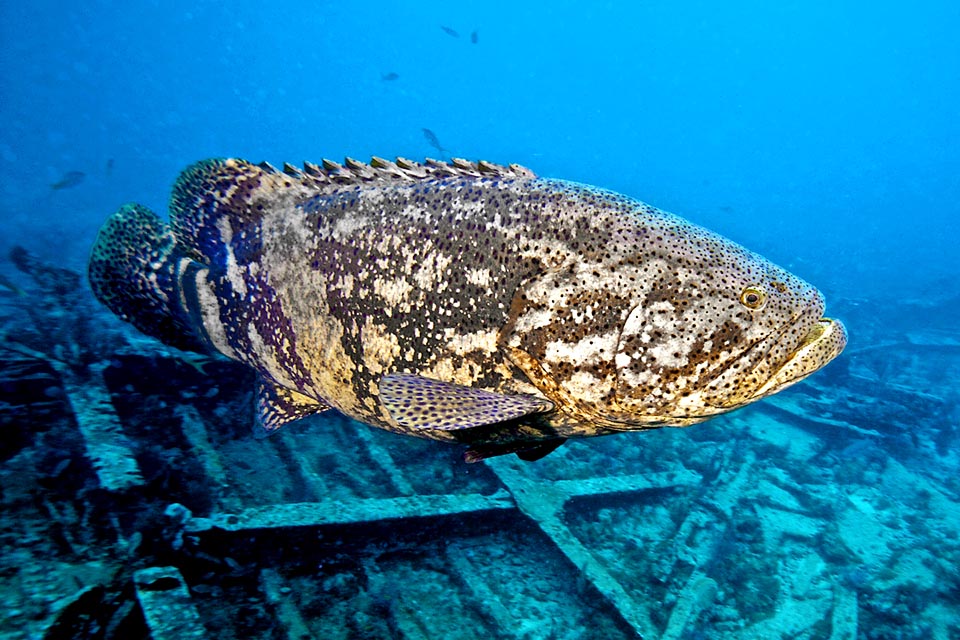
It loves hiding among the structures of the oil platforms and often chooses as house the wrecks of sunk ships © Allison & Carlos Estape
Characteristic is also the black dotting denser on the head, the upper part of the body and the fins.
The head is flat with a huge mouth and thick fleshy lips.
The head has curved canines for catching the prey whilst the mandible has none and towards the middle, on the sides, 3-5 rows of teeth for holding them and breaking the carapaces of the crustaceans.
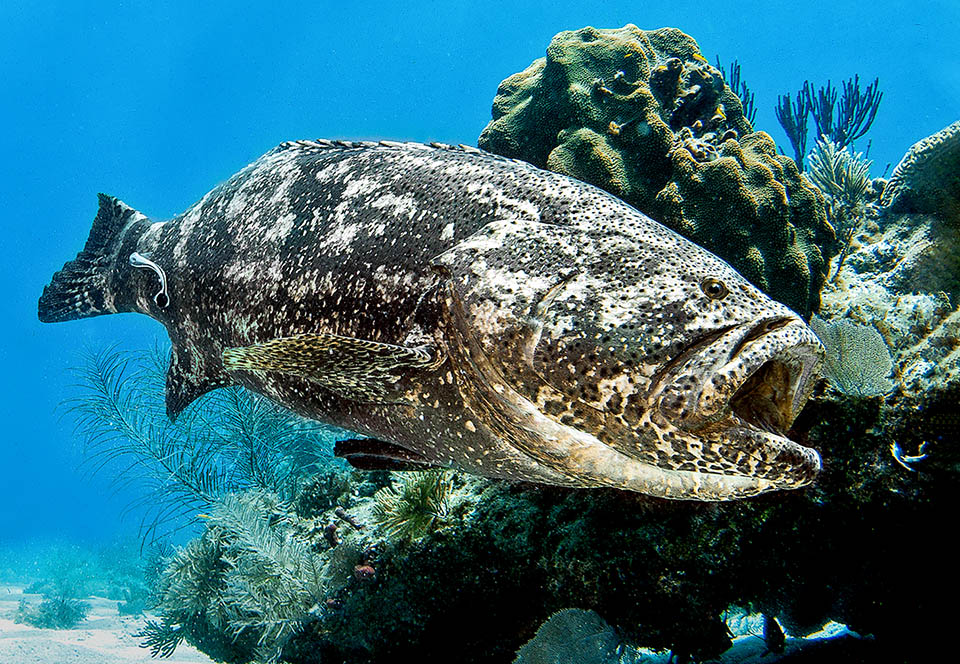
The old individuals, territorial and intolerant, do not even like intruders close to their den and quivering open mouth may attack also the divers © Karen Honeycutt
Before the eyes, apparently small compared to size, we note showy nostrils.
The preopercle is serrate and the opercula has 3 sharp spines, being the central one the most developed.
There is only one dorsal fin with 11 spiny rays and 15-16 soft, higher, that reach of the caudal peduncle. The anal, symmetrical, has 3 spiny rays and 8 unarmed.
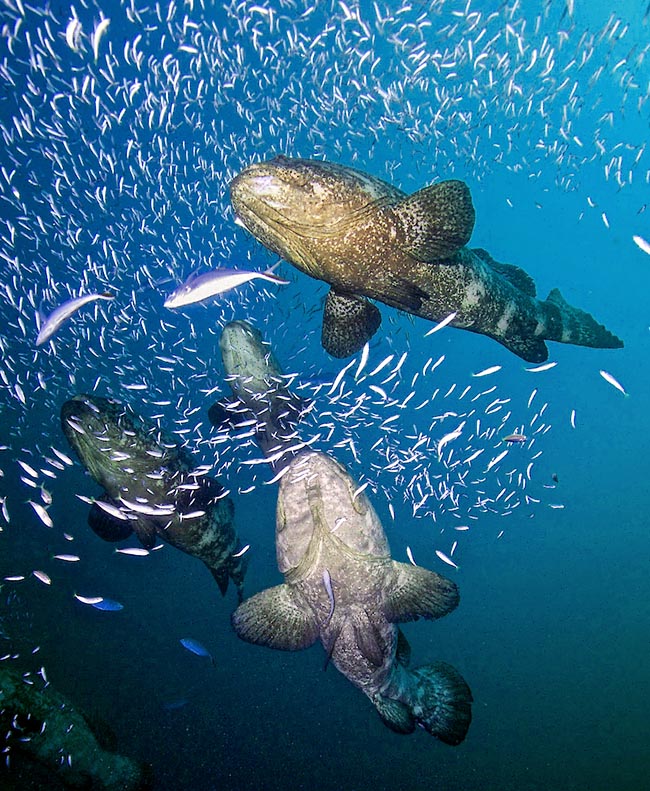
Epinephelus itajara feeds on fishes and crustaceans, mainly lobsters, but also octopuses and young turtles © Allison & Carlos Estape
The big pectoral ones, rounded like the pelvic, have 1 spine and 8-19 soft rays and also the imposing caudal fin is roundish.
The juveniles are tawny with well defined vertical bands.
Sexual maturity is reached in the males when 4-6 years old when they measure about 115 cm, and in the females later on, when 6-8 years, when their size is about 125 cm.
As usually it is the contrary, it does not seem that the Atlantic goliath grouper is, as hypothesized by some, a protogynous species, that is with females that while growing may turn into males.
Ethology-Reproductive Biology
Epinephelus itajara is a grouper usually living solitary, nourishing of crustaceans, 80% lobsters, bony fishes, including the pufferfishes, and cartilaginous fishes like rays, without forgetting the octopuses and, when is the case, the young turtles.
But the big sharks, the adult specimens do not have natural foes.
It is a territorial species, and when the divers approach its grotto or the wreck where it lives, it opens threateningly the mouth trembling with anger and if they do not run away because of fear it may even attack them.
Actually the main enemy of the Atlantic goliath grouper is man, who has always haunted it because of its excellent flesh.
For the reproduction take form aggregations of some dozens of individuals in sites favourable for the dispersion of the eggs, where the fishermen, who know them, carried out massacres for centuries without too many scruples.
It seems that the deposition takes place to couples in the middle of the night, regardless of the lunar phases, with males emitting dull calling sounds and caressing the females on the gills. They rise for a while in the water column and the fecundated eggs are abandoned to the currents. Also the larvae are pelagic until when they reach favourable coastal environments like the mangrove swamps.
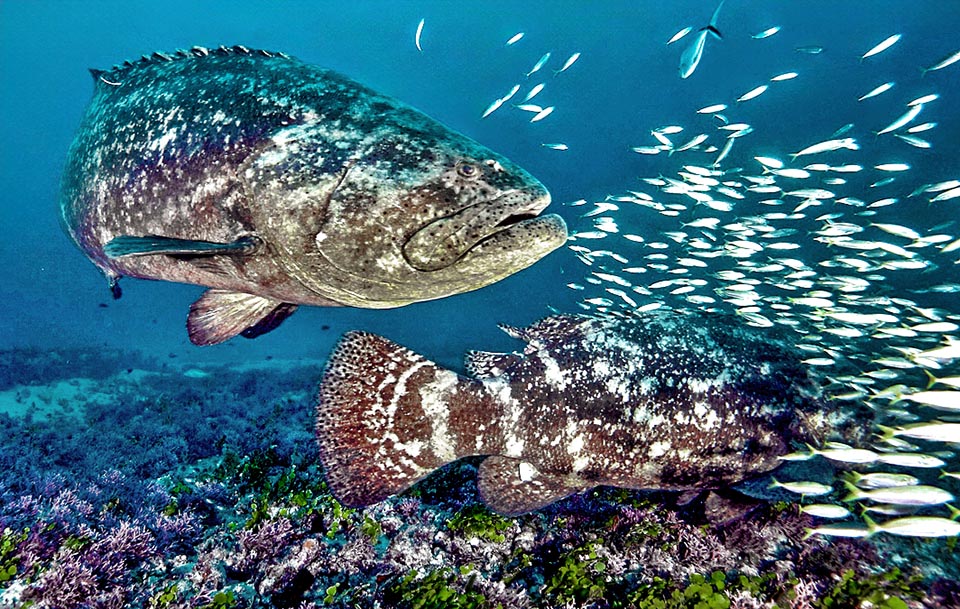
It preys, like here, small school fishes but also big cartilaginous fishes such as rays © Allison & Carlos Estape
The life expectancy for this grouper is of 37 years, there is even talk of 50, but these are data based by counting, like for the rings of the trees, the growth rings on the otoliths, calcareous concretions located in the inner ear, in the skull, that help the fishes to orient themselves and intercept the movements of the water, and their examination is unluckily possible only on passed away animals.
The resilience of the species is low, because for the doubling the populations are needed 4,5-14 years and the fishing vulnerability index, very high, marks 70 on a scale of 100.
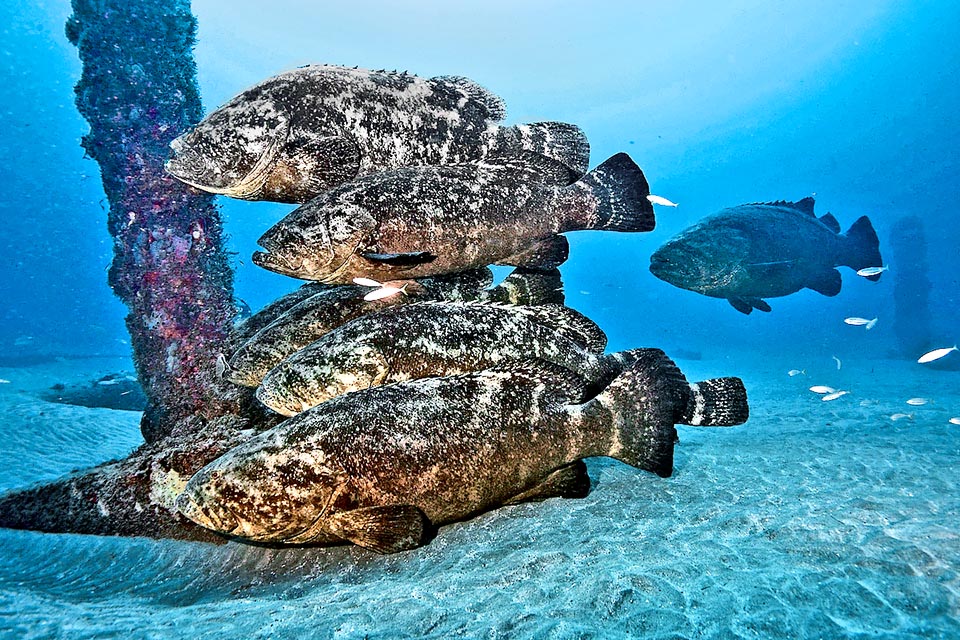
For reproduction, get form aggregations in sites known to fishermen who often do massacres, with no scruples, of this species presently considered vulnerable © Allison & Carlos Estape
In Florida have been found large concentrations of mercury in the tissues of these groupers that could damage their reproductive capabilities. Moreover, due to the human activities along the coasts, the mangroves are also declining with serious consequences for the juveniles. Epinephelus itajara appears nowadays as “Vulnerable” that is exposed, in the IUCN Red List of the endangered species.
Synonyms
Serranus itajara Lichtenstein, 1822; Promicrops itajara (Lichtenstein, 1822); Serranus mentzelii Valenciennes, 1828; Serranus guasa Poey, 1860.
→ For general information about FISH please click here.
→ For general information about BONY FISH please click here
→ For general information about CARTILAGINOUS FISH please click here.
→ To appreciate the BIODIVERSITY of BONY FISH please click here.
→ To appreciate the BIODIVERSITY of CARTILAGINOUS FISH please click here.
